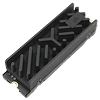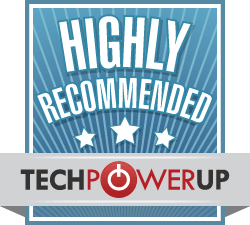 12
12
Corsair MP700 Elite 2 TB Review
(12 Comments) »Value and Conclusion
- According to Corsair, the MP700 Elite 2 TB will retail for $260, the version with heatsink for $270, or $10 more. Newegg has the MP700 Elite without heatsink listed for $250 already.
- Outstanding energy efficiency
- Very good real-life performance
- Fantastic synthetic performance results
- Impressive sequential transfer rates
- Good heatsink preinstalled, no throttling
- TLC (not QLC)
- Large SLC cache
- Compact form factor
- High price
- In real-life not significantly faster than the best Gen 4 drives
- Disappointing write speeds when SLC cache exhausted
- High idle power usage (desktop)
- DRAM-less design
Technology & Positioning
The Corsair MP700 Elite is the first SSD that we're testing that's based on Phison's new E31 controller. This is Phison's second Gen 5 controller for the consumer space—a cost optimized design, also taking into account lessons learned from one year of market dominance with the E26. While the high-end E26 will still be around as the flagship, the E31 is for drives that come at a price point between the high-end E26 drives and the best Gen 4 drives. One of the major requirements for that is DRAM-less operation, because it lets SSD vendors save some cost and design complexity. The DRAM cache does not store your data, it stores the mapping tables of the SSD that tells the controller where to find a certain piece of information. On DRAM-less SSDs, a small portion of the system's main memory can be used for the mapping tables. The Phison E31 uses 64 MB for that, similar to what other competing controllers use. The NAND flash used is Kioxia 218-layer 3D TLC.
Synthetic Performance
Phison are masters of optimizing their controllers for typical synthetic reviewer workloads on a mostly empty drive, and the E31 is no exception. In our synthetic testing, the drive shows impressive numbers that are among the best we've ever seen, topping even the E26 Gen 5 controller flagship in random IO. Phison did a great job eking out additional IOPS at the highly important low-threaded random IO workloads, because that's what matters most for real-life interactive workloads. I also like that 1M sequential mixed is greatly improved, which is very important, because it applies directly to file copy operations on the same drive, which read and write data at the same time. Sequential read and write is a little bit lower than on the E26 high-end drives, especially at low queue depth, because there's only four flash channels available instead of eight. When running with sufficiently high parallelism, the MP700 Elite drive reaches over 10 GB/s write and 9 GB/s read, which is a definite improvement over what Gen 4 drives can achieve, but a bit lower than the E26, which isn't unexpected. Maybe it's Corsair's naming scheme, which uses "MP700" for all Gen 5 drives so far and just tacks on "Elite/SE/Pro SE," which really gives no indication of performance for the average consumer.
Real-Life Performance
Our real-life testing is designed to run actual applications, not disk traces that compress time by assuming infinitely fast hardware and software. We're even running those tests with the drives filled to 85% capacity, not empty. This approach puts additional pressure on the various algorithms and the SLC cache, just like in real-life. Here the MP700 Elite does well, and ends up as the second-fastest drive in our test group, a tiny bit faster than the best Gen 4 drives, and 2% slower than the Corsair MP700 Pro. Overall I have to admit I'm a bit disappointed, because the drive isn't offering a noteworthy performance improvement over Gen 4 drives, except when it comes to sequential transfers. The next paragraph talks about performance when the SLC cache is exhausted, maybe that's a contributing factor affecting our real-life tests, because the drive is 85% full, which means there's not a lot of SLC cache left to work with. Don't get me wrong, the E31 isn't slow at all, rather the opposite, it worked through our workloads at impressive speed and with 100% stability.
SLC Cache / Sustained Performance
Corsair has configured their drive with an SLC cache size of 407 GB (or 60% in SLC mode), which is enough to soak up nearly all bursts of write activity. Once the SLC cache is exhausted, transfer rates drop quite a bit, to 1.4 GB/s and there's a second drop to 700 MB/s if you keep hammering the drive. Filling the whole 2 TB capacity completed at 1.1 GB/s, which is a bit lower than expected. Most mid- and high-end Gen 4 drives do better than that.
Power Consumption / Heat
Thermals of Gen 5 drives have always been challenging, with all requiring an active fan-cooled solution, or a huge heatsink, or both. One of Phison's development focuses was to lower heat output, which requires better energy efficiency. The new E31 is fabricated using a 7 nanometer process at TSMC Taiwan. Our power consumption testing shows that efficiency is truly stellar, it's the best drive we ever tested, beating even the Maxiotech MAP1602. In idle, power consumption is still pretty high though with 2 W, but that's not that big a deal, because it applies to desktop scenarios only. In a laptop config, the drive can reach its lowest ASPM power state easily, and uses only 0.074 W, which will help extend the battery life of laptops. With a maximum power draw of 5 W, the drive runs at less than half the power of the E26—very impressive. You still need a decent heatsink, the bare drive throttled fairly quickly with a stress-test workload. Good that Corsair has preinstalled an excellent heatsink that avoids throttling completely, even in our thermal stress test. Lighter consumer workloads should run fine without a heatsink, and a bit of throttling should be barely noticeable. Even when throttling, the drive was responsive and achieved solid performance of 3 GB/s—nice! We also tested with an aftermarket passive heatsink from Thermalright which ended up with a little bit of throttling, confirming that Corsair's heatsink has good cooling performance. The ability to run without active cooling is a huge benefit of the E31 controller over other PCIe Gen 5 SSDs.
Pricing & Alternatives
According to their marketing materials, Corsair's MP700 Elite was supposed to sell for $260, the version with heatsink for $270. This $10 increase is quite reasonable, on the other hand you can buy decent M.2 heatsinks on Amazon for $5-$10, but you'd have to install it yourself manually, which takes a few minutes of your time. The Corsair MP700 Elite is the first Gen 5 drive that I can really recommend, because it offers good performance without the hassle of a big heatsink with a noisy fan. However, at its current price point the MP700 Elite is MUCH too expensive. The most affordable E26 Gen 5 drives sell for $210 to $220—no reason the MP700 Elite should be more expensive than that, or are we being charged extra for "no fan or RAM" now? At the other end of the price range you have the top 2 TB Gen 4 drives like the Samsung 990 Pro ($150), WD SN850X ($155) and of course the MaxioTech MAP1602 drives like the Lexar NM790 ($150). I guess that means pricing has to eventually reach $200 and below to make sense, probably closer to $175. At this price point I could see people betting on the higher transfer rates willing to spend the extra cash, probably also for the bragging rights, and they won't have to compromise on noise levels of their rig, because no active cooling is needed.


The Corsair MP700 Elite is the first SSD that we're testing that's based on Phison's new E31 controller. This is Phison's second Gen 5 controller for the consumer space—a cost optimized design, also taking into account lessons learned from one year of market dominance with the E26. While the high-end E26 will still be around as the flagship, the E31 is for drives that come at a price point between the high-end E26 drives and the best Gen 4 drives. One of the major requirements for that is DRAM-less operation, because it lets SSD vendors save some cost and design complexity. The DRAM cache does not store your data, it stores the mapping tables of the SSD that tells the controller where to find a certain piece of information. On DRAM-less SSDs, a small portion of the system's main memory can be used for the mapping tables. The Phison E31 uses 64 MB for that, similar to what other competing controllers use. The NAND flash used is Kioxia 218-layer 3D TLC.
Synthetic Performance
Phison are masters of optimizing their controllers for typical synthetic reviewer workloads on a mostly empty drive, and the E31 is no exception. In our synthetic testing, the drive shows impressive numbers that are among the best we've ever seen, topping even the E26 Gen 5 controller flagship in random IO. Phison did a great job eking out additional IOPS at the highly important low-threaded random IO workloads, because that's what matters most for real-life interactive workloads. I also like that 1M sequential mixed is greatly improved, which is very important, because it applies directly to file copy operations on the same drive, which read and write data at the same time. Sequential read and write is a little bit lower than on the E26 high-end drives, especially at low queue depth, because there's only four flash channels available instead of eight. When running with sufficiently high parallelism, the MP700 Elite drive reaches over 10 GB/s write and 9 GB/s read, which is a definite improvement over what Gen 4 drives can achieve, but a bit lower than the E26, which isn't unexpected. Maybe it's Corsair's naming scheme, which uses "MP700" for all Gen 5 drives so far and just tacks on "Elite/SE/Pro SE," which really gives no indication of performance for the average consumer.
Real-Life Performance
Our real-life testing is designed to run actual applications, not disk traces that compress time by assuming infinitely fast hardware and software. We're even running those tests with the drives filled to 85% capacity, not empty. This approach puts additional pressure on the various algorithms and the SLC cache, just like in real-life. Here the MP700 Elite does well, and ends up as the second-fastest drive in our test group, a tiny bit faster than the best Gen 4 drives, and 2% slower than the Corsair MP700 Pro. Overall I have to admit I'm a bit disappointed, because the drive isn't offering a noteworthy performance improvement over Gen 4 drives, except when it comes to sequential transfers. The next paragraph talks about performance when the SLC cache is exhausted, maybe that's a contributing factor affecting our real-life tests, because the drive is 85% full, which means there's not a lot of SLC cache left to work with. Don't get me wrong, the E31 isn't slow at all, rather the opposite, it worked through our workloads at impressive speed and with 100% stability.
SLC Cache / Sustained Performance
Corsair has configured their drive with an SLC cache size of 407 GB (or 60% in SLC mode), which is enough to soak up nearly all bursts of write activity. Once the SLC cache is exhausted, transfer rates drop quite a bit, to 1.4 GB/s and there's a second drop to 700 MB/s if you keep hammering the drive. Filling the whole 2 TB capacity completed at 1.1 GB/s, which is a bit lower than expected. Most mid- and high-end Gen 4 drives do better than that.
Power Consumption / Heat
Thermals of Gen 5 drives have always been challenging, with all requiring an active fan-cooled solution, or a huge heatsink, or both. One of Phison's development focuses was to lower heat output, which requires better energy efficiency. The new E31 is fabricated using a 7 nanometer process at TSMC Taiwan. Our power consumption testing shows that efficiency is truly stellar, it's the best drive we ever tested, beating even the Maxiotech MAP1602. In idle, power consumption is still pretty high though with 2 W, but that's not that big a deal, because it applies to desktop scenarios only. In a laptop config, the drive can reach its lowest ASPM power state easily, and uses only 0.074 W, which will help extend the battery life of laptops. With a maximum power draw of 5 W, the drive runs at less than half the power of the E26—very impressive. You still need a decent heatsink, the bare drive throttled fairly quickly with a stress-test workload. Good that Corsair has preinstalled an excellent heatsink that avoids throttling completely, even in our thermal stress test. Lighter consumer workloads should run fine without a heatsink, and a bit of throttling should be barely noticeable. Even when throttling, the drive was responsive and achieved solid performance of 3 GB/s—nice! We also tested with an aftermarket passive heatsink from Thermalright which ended up with a little bit of throttling, confirming that Corsair's heatsink has good cooling performance. The ability to run without active cooling is a huge benefit of the E31 controller over other PCIe Gen 5 SSDs.
Pricing & Alternatives
According to their marketing materials, Corsair's MP700 Elite was supposed to sell for $260, the version with heatsink for $270. This $10 increase is quite reasonable, on the other hand you can buy decent M.2 heatsinks on Amazon for $5-$10, but you'd have to install it yourself manually, which takes a few minutes of your time. The Corsair MP700 Elite is the first Gen 5 drive that I can really recommend, because it offers good performance without the hassle of a big heatsink with a noisy fan. However, at its current price point the MP700 Elite is MUCH too expensive. The most affordable E26 Gen 5 drives sell for $210 to $220—no reason the MP700 Elite should be more expensive than that, or are we being charged extra for "no fan or RAM" now? At the other end of the price range you have the top 2 TB Gen 4 drives like the Samsung 990 Pro ($150), WD SN850X ($155) and of course the MaxioTech MAP1602 drives like the Lexar NM790 ($150). I guess that means pricing has to eventually reach $200 and below to make sense, probably closer to $175. At this price point I could see people betting on the higher transfer rates willing to spend the extra cash, probably also for the bragging rights, and they won't have to compromise on noise levels of their rig, because no active cooling is needed.


Feb 26th, 2025 05:17 EST
change timezone
Latest GPU Drivers
New Forum Posts
- RTX 50 Series silently removed 32-bit PhysX support. (54)
- Proposal to abolish votes on the Case Mod Gallery page (2)
- New build advice (8)
- Dune: Awakening benchmark - post your results (27)
- What are you playing? (23031)
- TPU's GPU Database Portal & Updates (387)
- How many continuous hours will it last my mini pc if connected to the LiitoKala battery pack that I've found for a cheap price ? (24)
- Is the ROPs and TMUs information of B570 in gpuz wrong? (0)
- Nvidia's GPU market share hits 90% in Q4 2024 (gets closer to full monopoly) (638)
- The TPU UK Clubhouse (25797)
Popular Reviews
- Corsair Xeneon 34WQHD240-C Review - Pretty In White
- ASUS GeForce RTX 5070 Ti TUF OC Review
- Corsair Virtuoso MAX Wireless Review
- MSI GeForce RTX 5070 Ti Ventus 3X OC Review
- MSI GeForce RTX 5070 Ti Vanguard SOC Review
- MSI GeForce RTX 5070 Ti Gaming Trio OC+ Review
- darkFlash DY470 Review
- AMD Ryzen 7 9800X3D Review - The Best Gaming Processor
- Gigabyte GeForce RTX 5090 Gaming OC Review
- Gigabyte X870 Aorus Elite WiFi 7 Review
Controversial News Posts
- NVIDIA GeForce RTX 50 Cards Spotted with Missing ROPs, NVIDIA Confirms the Issue, Multiple Vendors Affected (495)
- AMD Radeon 9070 XT Rumored to Outpace RTX 5070 Ti by Almost 15% (304)
- AMD Plans Aggressive Price Competition with Radeon RX 9000 Series (273)
- AMD Radeon RX 9070 and 9070 XT Listed On Amazon - One Buyer Snags a Unit (247)
- Edward Snowden Lashes Out at NVIDIA Over GeForce RTX 50 Pricing And Value (241)
- NVIDIA Investigates GeForce RTX 50 Series "Blackwell" Black Screen and BSOD Issues (241)
- AMD Denies Radeon RX 9070 XT $899 USD Starting Price Point Rumors (239)
- AMD Radeon RX 9070 and 9070 XT Official Performance Metrics Leaked, +42% 4K Performance Over Radeon RX 7900 GRE (184)